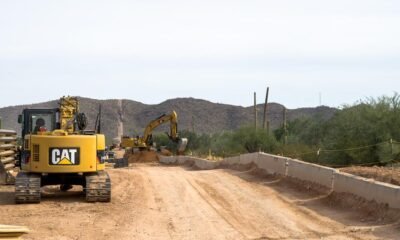border
Rising Migration Pressures Lead to Surge in Women’s Deaths at U.S.-Mexico Border

This article was originally published by The 19th.
On a sweltering June day in Southern Arizona, with temperatures soaring above 100 degrees, humanitarian aid workers discovered a group of migrants clustered in the scarce shade cast by the steel slats of the border wall. The group of about 30 migrants included a pregnant woman, an elderly woman, two women suffering from heat exhaustion, and young children. They were attempting to seek asylum and awaiting pickup by Border Patrol.
Increasingly, migrants find themselves stranded in the desert due to stringent restrictions under both the Trump and Biden administrations, which complicate asylum requests at official ports of entry. Consequently, they resort to crossing through perilous desert terrain. This decision is fraught with risk year-round but proves particularly deadly during the summer when temperatures soar and water sources are scarce.
Brad Jones, a volunteer and media liaison with Humane Borders, highlighted the harsh conditions even for those who manage to cross. “You are going to be waiting against a very large 30-foot-tall, heat-conducting wall, with very little in the way of shade,” he said. Migrants face the desert’s dangers, including disorientation, injury, and threats from criminal organizations.
The demographic of those crossing has shifted significantly over the years. Historically, the majority were Mexican men seeking employment. Since around 2010, however, migrants now often travel from countries like Venezuela, Honduras, Guatemala, and Haiti, driven by violence, political instability, and poverty. Families now make up a larger proportion of these migrants, including a rising number of women and children.
According to a report released in April by No More Deaths, a humanitarian aid organization, the Border Patrol’s El Paso sector, covering southwest Texas and the bootheel of New Mexico, reported a significant rise in migrant deaths. In 2023, deaths in the sector numbered 140, with women comprising 51 percent, marking the first instance where women outnumbered men among the deceased.
Data from Humane Borders and the Pima County medical examiner’s office corroborate this trend. In Arizona, women accounted for 22 percent of migrant deaths in 2023, a notable increase from previous years. This alarming rise in female fatalities is linked to the same factors driving migration: persecution, lack of employment opportunities, and climate change-induced hardships.
Women face unique dangers along the journey. Melanie Nezer, vice president of advocacy and external relations for the Women’s Refugee Commission, notes that climate change exacerbates food insecurity and displacement, leading to increased domestic and sexual violence. These factors compel many women to migrate, often with their children, to escape gang recruitment and provide a better future.
The cause of deaths among migrants spans environmental exposure, dehydration, hyperthermia, and injuries sustained trying to climb the border wall or swim through canals. The report by No More Deaths utilized data from medical examiners, news sources, and volunteer experiences, often documenting more deaths than official counts by U.S. Customs and Border Protection.
The “prevention through deterrence” strategy implemented in the 1990s, which aimed to funnel migrants through more dangerous terrain, continues to contribute to the rising death toll. Over 8,000 deaths along the U.S.-Mexico border have been recorded by the Border Patrol since 1998, with a significant concentration in the Sonoran and Chihuahuan deserts. The trend has only worsened with more restrictive asylum policies and increased migrant numbers.
Recent measures, such as placing concertina wire along the Rio Grande and deploying state troopers to the border, have potentially pushed more migrants into the already hazardous El Paso sector. Additionally, climate patterns exacerbating heat levels in regions like El Paso and Tucson have raised the stakes for migrants. For instance, El Paso experienced a record-breaking stretch of 100-plus degree days in 2023.
Of those who died, environmental exposure, dehydration, and hyperthermia were common causes. Pregnant women are especially vulnerable, with extreme heat heightening risks related to pregnancy, including preterm birth and miscarriage. For those who attempt to cross, like the migrants who chose to wait by the border wall, it’s not just a journey of hope but one rife with peril at every turn.
In summary, rising temperatures, more stringent policies, and desperate conditions combine to create a deadly equation for migrants at the U.S. Southern border. As summer progresses, advocates like Jones remain deeply concerned: “Border policy sometimes incentivizes risk. And that means entering in more remote areas could be fatal.”

















